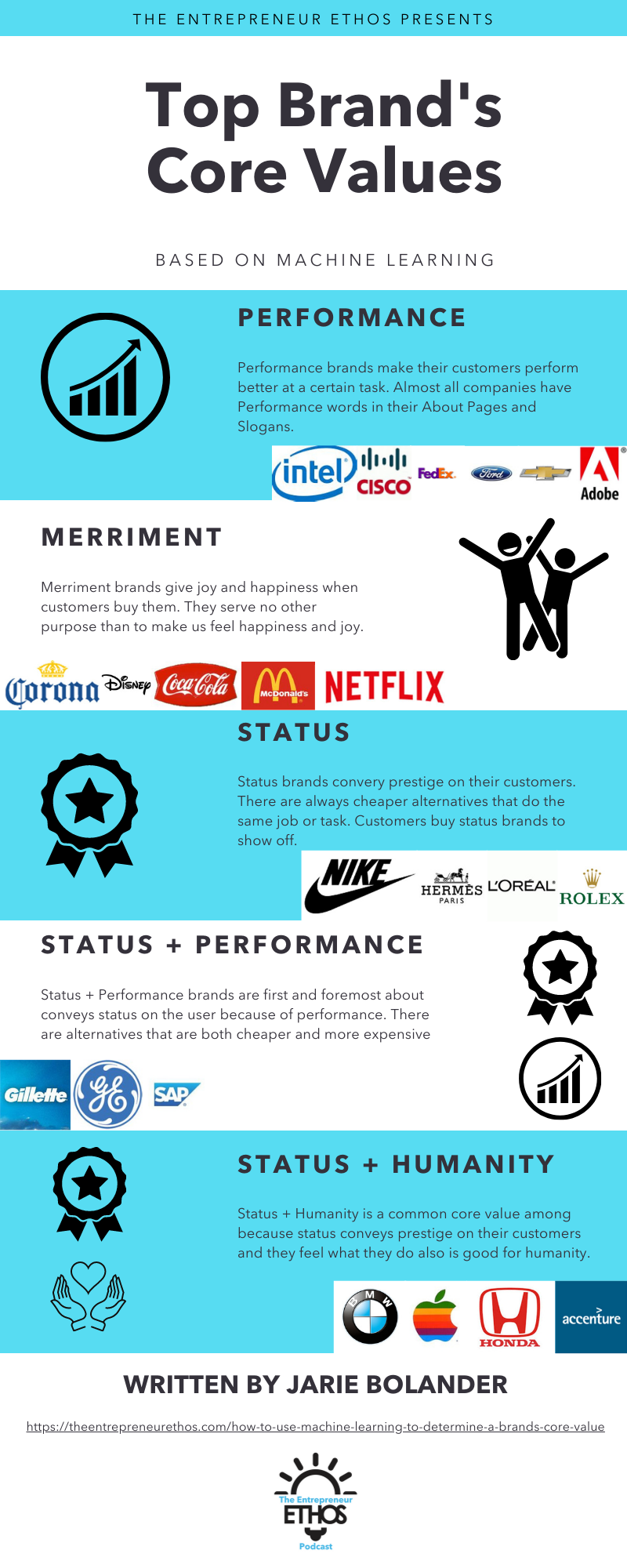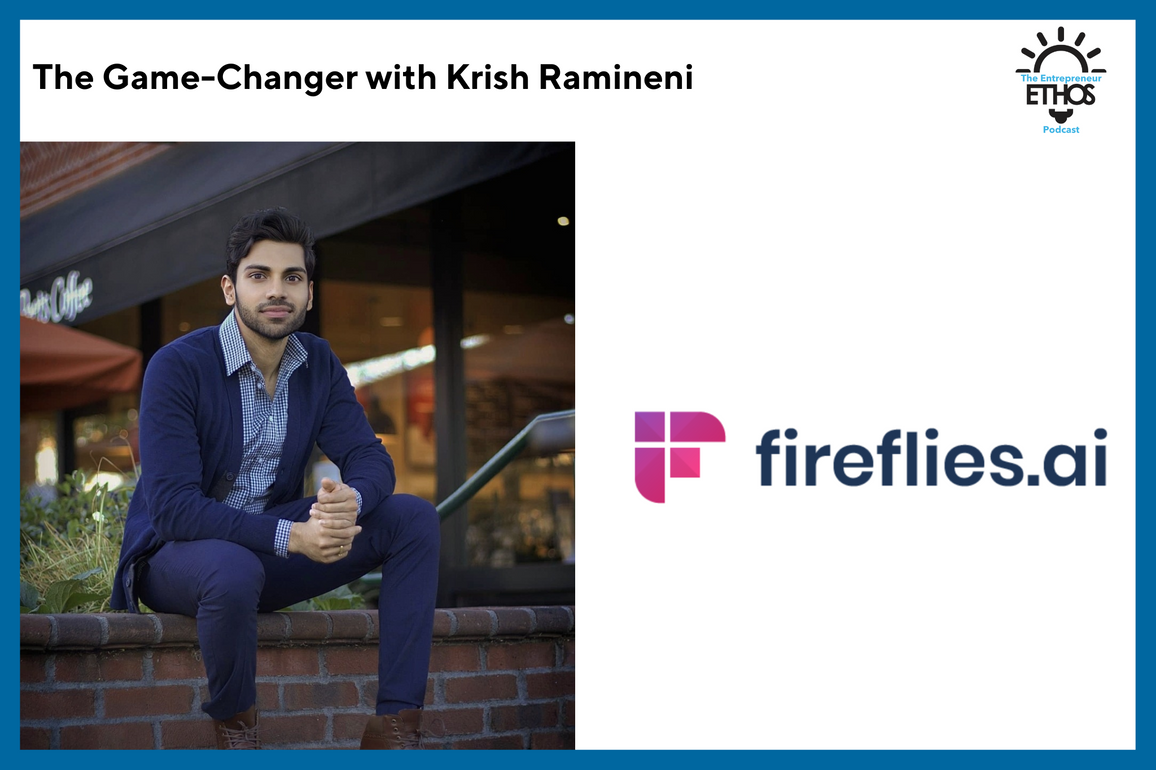How to Use Machine Learning to Determine a Brands Core Value

All brands have Core Values (CVs) that customers know them for. A survey, about pages, and slogans (Corpus) was put into Amazon’s Machine Learning (ML) Natural Language Processing (NLP) service Comprehend Topics to determine the Brand Core Values (BCVs) of the top 70 brands on the Forbes list of most valuable brands of 2019. This was done to determine if a common set of CVs exists among these top brands so that additional commonalities can be looked at.
Ten BCV’s were used for survey choices along with their three most positive value progressions. The ten chosen were Equality, Performance, Humanity, Worldview, Morality, Status, Love, Belonging, Cowboy, and Merriment. These were chosen based on the Content leaf of the Story Grid’s Five Leaf Genre Clover, which classifies stories into specific content genres for analysis. The idea being that, like stories, brands have a Genre in which they tell their story.
Amazon’s Comprehend Topics service was used to do topic analysis on the corpus since it was familiar to the author and uses Latent Dirichlet Allocation, which seems like the best choice to find common topics among lots of text files. The corpus was a collection of text files of survey results, slogan, and about.
Topic Analysis Results Summary
Comparisons were made to see which topics were assigned to which file. This method was chosen as a way to see if any common CVs were present among the different types of files (survey, slogan, and about).
The most common set of CVs (list of terms or topics outputted by Comprehend) for the survey were topics 0,1,2, and 17 out of a total of 20 (0-19).
Slogans and About Page text varied more across the topics with topic 17 having the most frequency among all three.
Topics 0,1,2, and 17 had the following terms (with weights):
- Topic 0: life (0.09), love (0.08), health (0.07), planet, day, solution, logistic, solver, problem, unite
- Topic 1: prestige (0.26), status (0.21), success (0.14), desire (0.08), performance (0.08), advantage, respect, worldview, competent, honor
- Topic 2: joy (0.23), happiness (0.23), belong (0.17), merriment (0.08), humanity, life, freedom, success, desire, love
- Topic 17: business (0.41), improve (0.05), productive (0.03), work, Marlboro, love, improvement, coffee, let's, home
The weights (in parentheses) are the strength of the term within the topic. The higher the number, the stronger the term within the topic. Since the terms for the survey were selected ahead of time, it makes sense that those terms would show up with an increased weight.
There are strong indications for Humanity, Performance, Status, and Merriment BCV’s among the brands in the analysis cohort. Results did vary from the survey, slogan, and about data with topic 17 - business, improve, productive, being the most common among all three. This indicates that Performance + Status BCVs is a combo that most brands want to be associated with.
It also appears that most brands have more than one BCV with Performance and Status being the most common combination followed by Humanity + Love. The resulting infographic below shows the findings.

What is a Brand Core Value?
Successful brands have core values that they are known for. These values take a customer from the negative (or lack of the value) to the positive (of having the value.
Values define the respect to worth, excellence, usefulness, or importance of a brand or product. For example, the shoe company Nike might have the value of Performance, or rather if you use a Nike product, your Performance will improve (among other things).
The concept of the BCV is an extension of the Story Grid’s Five Leaf Genre Clover of a story. The five leaves of the clover define Time, Reality, Style, Structure, and Content. The last one, Content, is where the stories Life Values are defined. These life values are the changes that will take place within the story.
Getting back to our Nike Performance example, a Performance content story (according to the Story Grid method) will take the protagonist from a Life Value (LV) of Shame (negative) to Honor (positive) as summed up below:
“The performance story is a big crowd-pleaser because it concerns a life-changing pressure cooker moment...when we must perform on-demand and either attain respect or live with ignominious shame.” -- Shawn Coyne
Story Grid Content Genre Can Be Applied to Brands
It’s not too big a stretch to see that a brand can also have a content genre in which to tell its story. This content genre is what I call the Brand Core Value since it’s these values that any communications (be it social, marketing, PR, etc.) need to adhere too.
This work will use Surveys and Machine Learning to take a first pass at what the core values of the most valuable brands (the top 70 actually) according to Forbes in 2019. Once the Brand Core Values are determined, the work will continue to define the Marketing Six-Core Questions (modeled after the Editor Six-Core Questions) to create a framework to analyze any brands messaging to determine if it’s consistent and aligned to what they want to communicate.
Why Care About a Brand Core Value?
A Brand’s Core Value (BCV) is the primary value a brand is recognized for. The importance of a BCV is that it unifies the messaging and the stories that a brand tells it’s customers (and potential customers). These messages and stories are important to be clear, concise, compelling, and most importantly consistent so that the message gets through all the noise in the world.
A brand that does not have its story straight will only confuse customers and wonder why their marketing, PR, and social media are not making the impact it should.
The full analysis can be downloaded here.

